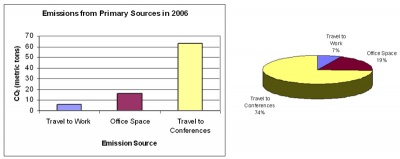The Project Goes Carbon Neutral
The Project on Emerging Nanotechnologies Strives to Reduce Emissions – and Goes Carbon Neutral
 As part of its overall goal to minimize risks to humans and the environment the Project is working to reduce its impact on climate change. Although we are a small full-time staff of eight people, we recognize that our activities add to the rising global greenhouse gas emission levels. We are committed to reducing these levels and mitigating their impact.
As part of its overall goal to minimize risks to humans and the environment the Project is working to reduce its impact on climate change. Although we are a small full-time staff of eight people, we recognize that our activities add to the rising global greenhouse gas emission levels. We are committed to reducing these levels and mitigating their impact.
In addition to carrying out internal energy and waste conservation efforts, PEN decided to estimate and offset its carbon footprint. We provide a brief overview below of our emission results, the analysis behind those estimates, an explanation of the offset strategies and providers we have chosen for our 2006 emissions, and our internal reduction and conservation efforts going forward.
Emissions from our Project and Activities
Our Project’s activities during 2006 were associated with approximately 85 metric tons of carbon dioxide (CO2) or 7 metric tons of CO2 per month. This estimate includes travel to work (6 metric tons CO2/year), office space (16 metric tons CO2/year), and the largest source—air travel to and from conferences/events (63 metric tons CO2/year), as shown below. Air travel contributed to nearly 75 percent of our emissions.

The estimate of our footprint does not include all sources of emissions. For instance, we did not estimate indirect emissions from waste generated and landfilled, or indirect emissions from electricity used for shared space at the Wilson Center (e.g., library, cafe, bathrooms).
To put our emissions in perspective, the roughly 85 metric tons of CO2 emitted in 2006 that were associated with our travel and office space are equivalent to annual emissions from about 19 average U.S. cars or four average U.S. residents.
In order to account for variations in our emissions and to ensure we achieve a total offset, we have added an additional 10 percent to our target and will offset 93 metric tons. This may result in the project going carbon negative.
Emissions Analysis
To estimate our carbon footprint, we focused on the largest sources of emissions associated with our activities – travel and office electricity use. We used existing emissions calculators and plausible assumptions where we were constrained by data or time limitations.
For total office space electricity emissions, we applied a square footage approach: multiplying our project space square footage by a factor for annual electricity consumption (in kWh per square foot for buildings constructed between 1990-1999), and then by an electricity CO2 emission factor from the Environmental Protection Agency. We used this approach because we were unable to obtain data on electricity and steam purchased by our building to estimate the indirect emissions from fossil fuels burned to generate the electricity and heat used by our share of the total space. Because we wanted to verify the reasonableness of our electricity emission estimate, we carried out a bottom-up calculation based on known quantities, power use, and consumption of electronic equipment and lighting in our offices. As shown in the graph below, this equipment contributes to about 7 metric tons of CO2 emissions per year. Because this is well below our estimated total office space emissions of 16 metric tons of CO2, we believe that our office space emission estimate is conservative.
To estimate travel emissions to and from work, we used mileage traveled by subway or car for each staff member, a U.S. commuter rail emission factor from the Employee Commuting CO2 Emissions Calculator developed by the World Resources Institute and the World Business Council for Sustainable Development, vehicle fuel economy information, and the online Climate Care vehicle emissions calculator. To estimate business travel emissions to and from various conferences and events, we calculated mileage traveled by our staff, both domestically and internationally, and estimated CO2 per trip using the CarbonCounter.org calculator maintained by The Climate Trust.

Offset Providers Chosen
What does it mean to offset emissions?
“Offset means “neutralize,” “balance,” or “cancel out.” When we do certain activities like drive, fly or heat our homes we emit carbon dioxide. Carbon offsets counteract these activities by funding projects that remove carbon dioxide from the atmosphere.” –Carboncounter.org
Based on our review of a selection of carbon offset programs and reports including “A Consumers’ Guide to Retail Carbon Offsets” and “Offsetting Emissions: A Business Brief on the Voluntary Market,” and speaking with representatives from various companies, we chose The Climate Trust for our travel emission offsets and Solar Electric Light Fund (SELF) to offset emissions associated with our electricity.
 The Climate Trust has been in business since 1997 (longer than most offset providers) and funds a broad range of unique projects in the United States including a new energy efficient paper mill in Massachusetts, a blended cement concrete project, preservation of a native Northwest forest, and even a truck stop electrification project. This company has already offset 1.9 million metric tons of CO2. Ninety-two percent of the money from PEN’s offset purchases will help fund future projects that meet the Climate Trust’s tests for additionality. These tests ensure that a given project goes beyond regulatory frameworks and “business as usual,” and faces implementation barriers (financial, technological, and institutional) that are solved by carbon funding. In other words, the Climate Trust does not fund anything that would have happened without the funding from offsets. By offsetting our travel emissions, we will prevent the release of an additional 75 metric tons of CO2 into the atmosphere through the Climate Trust’s portfolio of energy efficiency, renewable energy, cogeneration, sequestration, material substitution, and transportation efficiency projects.
The Climate Trust has been in business since 1997 (longer than most offset providers) and funds a broad range of unique projects in the United States including a new energy efficient paper mill in Massachusetts, a blended cement concrete project, preservation of a native Northwest forest, and even a truck stop electrification project. This company has already offset 1.9 million metric tons of CO2. Ninety-two percent of the money from PEN’s offset purchases will help fund future projects that meet the Climate Trust’s tests for additionality. These tests ensure that a given project goes beyond regulatory frameworks and “business as usual,” and faces implementation barriers (financial, technological, and institutional) that are solved by carbon funding. In other words, the Climate Trust does not fund anything that would have happened without the funding from offsets. By offsetting our travel emissions, we will prevent the release of an additional 75 metric tons of CO2 into the atmosphere through the Climate Trust’s portfolio of energy efficiency, renewable energy, cogeneration, sequestration, material substitution, and transportation efficiency projects.
SELF, a Washington, DC based company that has been in business over fifteen years, helps villagers in developing countries install clean solar photovoltaic panels systems, instead of burning kerosene or diesel. These projects help build local capacity and are often led by women. By offsetting emissions from our electricity use, we will contribute to the development of a solar electrification project in Benin, West Africa, which will replace inefficient fossil fuel generated lighting.
Internal Reduction and Conservation Efforts
We are actively trying to reduce our carbon footprint internally, in addition to offsetting it. Below are efforts that we are taking to reduce emissions and conserve resources.
Travel
Air travel to and from conferences and meetings offers us the greatest opportunity for reducing emissions since this source accounts for three-quarters of our total footprint.
Steps we are taking include:
- Equipping all new computers with video-conferencing capability.
- Video or teleconferencing instead of traveling to meetings, where feasible and appropriate. We seek to reduce air travel emissions by 20 percent in 2007.
- Avoiding airmail, where feasible.
Office Space Electricity
Our electricity reduction goals focus on our two greatest sources of electricity emissions: lighting and computer use. Steps we are taking include:
- Purchasing low wattage halogen bulbs that fit standard incandescent fixtures, offer the energy savings of the fluorescents with better light and without end-of-life mercury issues.
- Purchasing and installing light emitting diodes (LEDs) that use up to 90 percent less energy than incandescents and have a useful life that is about 30 times longer than an incandescent source and about 5 times longer than a compact fluorescent light source.
- Installing a duplexer on our shared printer for double-sided printing.
- Employing remote office locations to reduce emissions and energy use.
- Unplugging battery chargers (for cell phones, laptops, and other peripherals) when not in use.
- Looking into the costs and benefits of installing motion sensors in our offices with overhead lighting.
Efforts we are taking individually include:
- Turning off lights and lamps when away from our desks, at meetings, lunch, and at the end of the day.
- Adjusting our computer power settings to save energy (e.g., setting the monitor to turn off after 5 minutes of inactivity and system standby after 10 minutes).
- Putting our computers to “sleep” while away from our desks during the day.
- Shutting down computers and turning off our monitors at the end of the day.
- Printing and copying using double-sided settings (not only saves energy, but also time, money, and paper).
Material Use and Waste
Although we did not estimate indirect greenhouse gas emissions associated with waste generated and materials used by our Project, there are still many opportunities for us to reduce waste and reexamine our procurement practices. Steps we are taking include:
- Printing future publications on recycled paper with soy-based inks.
- Reducing waste, increasing recycling efforts, and working with Wilson Center and GSA staff to ensure that paper, bottles, cans, and cardboard boxes are indeed recycled.
- Working with Wilson Center staff to reduce waste from catered events.
- Exploring options for purchasing post-consumer recycled paper for in-house printing and copying.
- Using local suppliers of materials where feasible.
If you would like more information on our calculations or offset and emission reduction strategies, please contact Deanna Lekas at: deanna.lekas@wilsoncenter.org or 202-691-4398.
Sources:
For in-line citations please View this article as pdf
1-Based on average annual car and U.S. resident emissions presented in “A Consumers’ Guide to Retail Carbon Offsets” prepared by Trexler Climate + Energy Services for Clean Air-Cool Planet, December 2006. 2-http://www.ghgprotocol.org/templates/GHG5/layout.asp?type=p&MenuId=OTAx
3-http://www.fueleconomy.gov/feg/findacar.htm
4-http://www.climatecare.org/calculators/car_calc.cfm Mileage calculated using 5-http://www.usatoday.com/travel/flights/miles/calculator.htm.
6-http://www.carboncounter.org
7-Clean Air-Cool Planet. “A Consumers’ Guide to Retail Carbon Offsets.” Prepared by Trexler Climate + Energy Services for Clean Air-Cool Planet, December 2006. http://www.cleanair-coolplanet.org/ConsumersGuidetoCarbonOffsets.pdf
8-Business for Social Responsibility and the Katoomba Group’s Ecosystem Marketplace. “Offsetting Emissions: A Business Brief on the Voluntary Market.” December 2006. http://www.bsr.org/meta/BSR_Voluntary-Carbon-Offsets.pdf.
9-“Proposal for Decorative Light Strings for Inclusion as Part of the ENERGY STAR Program Version 1.1.” Prepared for the U.S. Environmental Protection Agency by Natural Resources Canada Office of Energy Efficiency and Navigant Consulting, Inc. March 2006. http://www.energystar.gov/ia/partners/prod_development/new_specs/downloads/Prog_Dev_Criteria_for_SLEDs.pdf
10-EERE. “Lifetime of White LEDs Factsheet.” Energy Efficiency and Renewable Energy, U.S. Department of Energy. PNNL-SA-50957, August 2006. http://www.netl.doe.gov/ssl/general_illumination_life_measuring.htm
April 13, 2007
Summary
As part of its overall goal to minimize risks to humans and the environment the Project is working to reduce its impact on climate change. Although we are a small full-time staff of eight people, we recognize that our activities add to the rising global greenhouse gas emission levels. We are committed to reducing these levels and mitigating their impact.
Files
For in-line citations please View this article as pdfSELF CertificateClimate Trust Certificate
